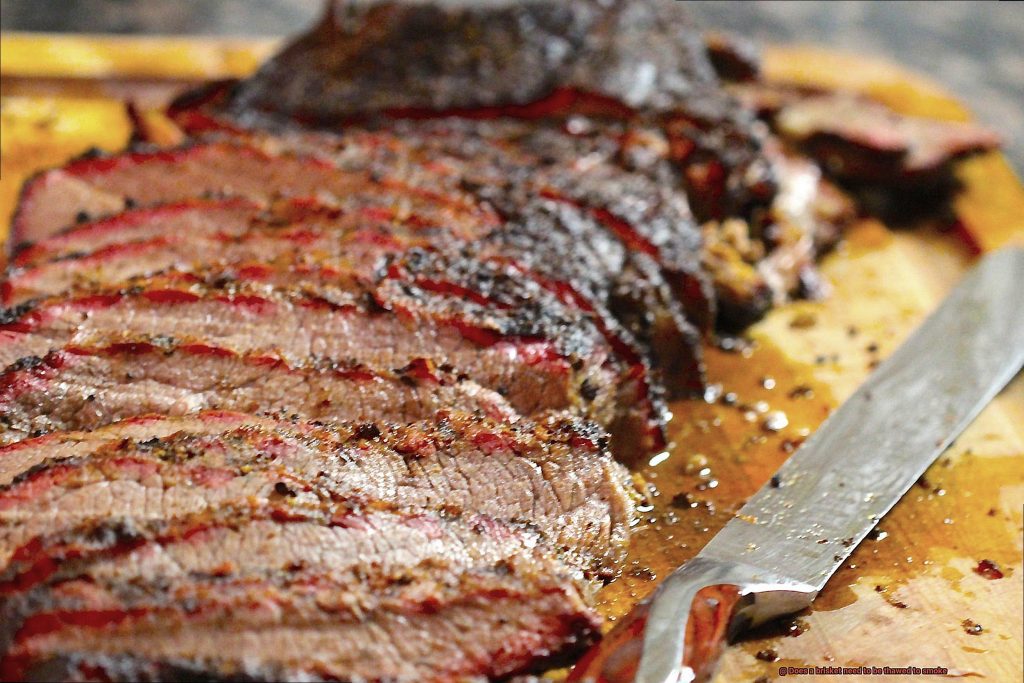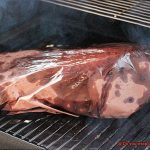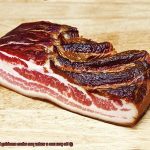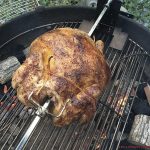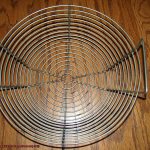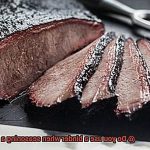Welcome to the tantalizing world of brisket smoking. If you’re a BBQ fanatic, then you know there’s nothing quite like the savory aroma of slow-cooked meat. But if you’re new to this game or just seeking to up your BBQ skills, you may be wondering whether thawing your brisket is necessary before smoking it. Well, the answer isn’t so cut and dried and requires some knowledge of proper smoking techniques.
So, what’s the scoop on thawing brisket before smoking? Does it make a significant difference? And what happens if you skip this step? These are all valid questions that warrant an informed response. In this post, we’ll delve into the nitty-gritty of smoking brisket, including why thawing is crucial, its benefits, and what occurs if you don’t defrost your meat.
Whether you’re a seasoned pit master or a curious novice, this article will equip you with everything you need to know before firing up your smoker for your next brisket. So sit back, crack open a cold one and get ready to learn about the key to perfect brisket smoking: to thaw or not to thaw.
Contents
What is a Brisket?
A brisket is a large, tough muscle that comes from the lower chest region of a cow. This cut of meat is perfect for slow-cooking methods like smoking, as it has a high amount of connective tissue that breaks down over time, resulting in tender and flavorful meat.
A brisket is made up of two parts: the flat and the point. The flat is leaner and more uniform in shape, while the point is fattier and has a more irregular shape. When purchasing a brisket, look for one with good marbling throughout the meat. This will help keep the meat moist during cooking and add flavor.
Briskets can be found both fresh and frozen, but it’s important to thaw them properly before smoking. While some may argue that a frozen brisket can be smoked without thawing, it’s generally recommended to thaw the meat first. Thawing allows for more even cooking and better absorption of any marinade or rub used. Thawing should be done slowly in the refrigerator over several days, rather than using quick methods like running under hot water.
Once your brisket is thawed, it’s time to prepare it for smoking. Begin by trimming any excess fat from the meat, leaving about ¼ inch of fat on top to help keep the meat moist during cooking. Apply your chosen rub or marinade, making sure to cover all sides of the meat.
When smoking a brisket, maintaining a consistent temperature throughout the cooking process is paramount. Aim for a temperature between 225-250°F and smoke the brisket for 1-1.5 hours per pound of meat. Use wood chips or chunks for added flavor and wrap the brisket in foil or butcher paper halfway through cooking to help keep it moist.
Why Should a Brisket Be Thawed Before Smoking?
You might be wondering if it’s necessary to thaw the meat before smoking. As an expert in this field, I can tell you with confidence that yes, you absolutely should thaw your brisket before smoking it.
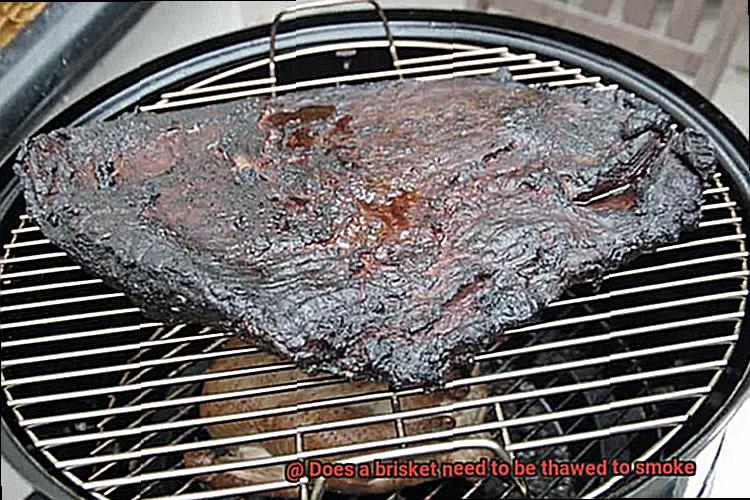
Firstly, attempting to smoke a frozen brisket can lead to unevenly cooked meat. The inside of the meat will remain frozen while the outside is cooked, resulting in a less than appealing texture. Thawing the brisket beforehand ensures that it will cook evenly throughout, guaranteeing a delicious and tender end result.
Secondly, thawing your brisket allows you to properly season the meat. Ice crystals often cover the surface of frozen meat, making it difficult for seasonings to adhere properly. Thawing your brisket allows you to apply your desired rub or marinade evenly, ensuring maximum flavor absorption.
Additionally, thawing your brisket can help save time and energy during the smoking process. Smoking a frozen brisket takes significantly longer to cook than a thawed one. This means more fuel usage and more time monitoring the smoker. Thawing your brisket beforehand can help ensure that your smoking process is efficient and effective.
To summarize, here are three reasons why thawing your brisket before smoking is crucial:
- Even cooking throughout the meat.
- Proper seasoning absorption.
- Saving time and energy during the smoking process.
How to Thaw a Frozen Brisket
Thawing the brisket safely and effectively is important to avoid any potential food safety issues and ensure that it cooks evenly. Here are five sub-sections that explain how to thaw a frozen brisket:
Thawing in the Refrigerator:
Thawing a frozen brisket in the refrigerator is the safest method. It is recommended to allow 24 hours of thawing time for every five pounds of meat. This method may take longer, but it ensures that the meat stays at a safe temperature throughout the thawing process. To thaw a brisket in the refrigerator, place it on a tray or plate and cover it with plastic wrap or aluminum foil to prevent contamination. Place it in the lowest part of the refrigerator where the temperature is most consistent.
Thawing in Cold Water:
If you’re short on time, you can also use the cold water method to thaw your brisket. Place the frozen brisket in a leak-proof bag and submerge it in cold water. Change the water every 30 minutes to ensure that it stays cold. This method can take several hours, depending on the size of the brisket. It is important to note that this method should not be used if there is any chance of contamination as it can increase bacterial growth.
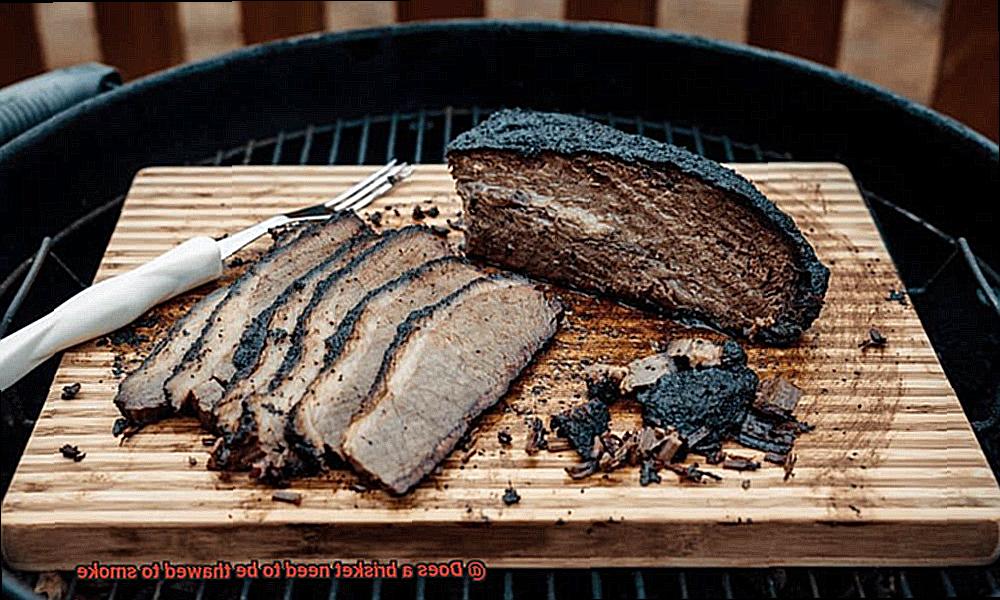
Avoid Thawing at Room Temperature or in Warm Water:
Never thaw your brisket at room temperature or in warm water as this can lead to bacterial growth and potential foodborne illness. Bacteria grow rapidly at room temperature, so it’s important to keep your meat at a safe temperature during the thawing process.
Say No to Microwave:
Some people may be tempted to use a microwave to thaw their brisket, but this method should be avoided as it can partially cook the meat and lead to uneven cooking. It’s best to plan ahead and allow enough time for proper thawing using either the refrigerator or cold water methods.
Plan Ahead:
It’s always best to plan ahead and allow enough time for proper thawing using either the refrigerator or cold water methods. Thawing a frozen brisket in the refrigerator may take longer, but it’s the safest way to thaw your brisket. On the other hand, thawing in cold water is faster but requires more attention.
Benefits of Thawing a Brisket Before Smoking
You want to make sure that every step of the process is done right, and that includes thawing your meat properly. The benefits of thawing a brisket before smoking it are numerous, and will result in a more succulent and flavorful piece of meat.
Firstly, thawing your brisket ensures even cooking from the outside to the inside. Smoking a frozen brisket leads to uneven cooking where the outside can quickly cook while the inside remains undercooked. This results in tough and dry meat on the exterior and undercooked meat on the interior. Thawing your brisket before smoking it ensures that it cooks evenly, resulting in tender and juicy meat.
Secondly, proper thawing allows for better seasoning of your brisket. A frozen brisket prevents seasoning from penetrating into the meat as well as it would if it were thawed. This can lead to bland or unevenly seasoned meat. By thawing your brisket beforehand, you allow the seasoning to fully penetrate the meat, resulting in a perfectly flavored dish.
Thirdly, thawing reduces cooking time. A frozen brisket takes longer to cook than a thawed one, so thawing beforehand saves you time and effort. This means less time tending to your smoker or grill and more time enjoying your delicious meal.
Lastly, thawing allows you to inspect your brisket for any signs of damage or spoilage before cooking it. If you notice any discoloration or foul odor, you can discard the brisket before wasting time and effort trying to smoke it. This ensures that you’re cooking with fresh and safe ingredients.
Potential Risks of Not Thawing a Brisket Before Smoking
As a brisket aficionado, you know that smoking this cut of meat is an art form that requires patience and attention to detail. However, one crucial step that cannot be rushed is thawing your brisket before smoking it. Failure to do so can lead to potential health risks and an unappetizing end product.
Let’s delve into the potential risks of not thawing a brisket before smoking it.
Firstly, not properly thawing a brisket can cause harmful bacteria to develop. When meat is frozen, any bacteria present in the meat becomes dormant. However, when the meat thaws, these bacteria can quickly become active and multiply if the meat is not cooked at the right temperature. Attempting to smoke a frozen brisket increases the likelihood of harmful bacteria like E. coli or Salmonella being present in the meat. These bacteria can cause serious illness if they are not killed off during the cooking process.
Secondly, not thawing a brisket before smoking can result in uneven cooking. Ice crystals form inside the muscle fibers when a piece of meat is frozen. These ice crystals can cause damage to the muscle tissue, resulting in uneven cooking and a dry, tough final product. Smoking a frozen brisket leads to the outer layer of the meat cooking much faster than the center, resulting in an overcooked exterior and an undercooked interior.
Moreover, proper thawing allows for even seasoning and shorter cooking times. It also enables you to inspect the meat for any flaws before smoking it.
To avoid these potential risks, always take the time to properly thaw your brisket before smoking it. Thawing your meat ensures even cooking, minimizes bacterial growth, and results in tender, juicy meat that will leave your taste buds craving more.
Tips for Safely Thawing and Smoking a Brisket
One crucial step that should never be overlooked is safely thawing your meat. Thawing a brisket not only ensures even cooking but also prevents potential health hazards from consuming undercooked meat. Here are five tips for safely thawing and smoking a brisket that will make your BBQ experience both delicious and safe.
Thawing Methods
To safely thaw a brisket, you have two options. The first involves placing it in the refrigerator for 24-48 hours before smoking. This slow and safe thawing method keeps the meat at a consistent temperature. The second method is using the cold water method, which involves submerging the brisket in cold water and changing the water every 30 minutes until fully thawed. Avoid thawing at room temperature or using hot water, as this can lead to bacterial growth and potential food poisoning.
Room Temperature
Once fully thawed, let the brisket come to room temperature before smoking. This allows for even cooking and prevents the brisket from being too cold in the center. Letting the brisket sit at room temperature for 1-2 hours before smoking is recommended.
Seasoning
While the brisket is coming to room temperature, take advantage of this time to season it with your desired spices and rubs. Make sure to cover all sides of the brisket evenly with seasoning to enhance its flavor.
Smoking
Follow your smoker’s instructions for proper heating and cooking time. It’s recommended to smoke the brisket at a low temperature (225-250°F) for several hours until it reaches an internal temperature of 195-205°F. Consistent temperature throughout the cooking process is key, so invest in a quality smoker and monitor the temperature regularly.
Safety First
Always prioritize safety when handling raw meat. Use a meat thermometer to ensure that the brisket has reached a safe internal temperature of at least 145°F. Also, ensure to trim any excess fat and place the brisket in a leak-proof container or on a tray to prevent any drips or contamination of other foods in the fridge.
ZT3m4xV34V0″ >
Conclusion
In conclusion, it’s crucial to thaw a brisket before smoking to achieve the best possible results. Thawing ensures that the meat cooks evenly, resulting in a tender and juicy final product. Additionally, it allows for better seasoning absorption, ensuring that your desired flavors permeate the meat thoroughly. Plus, thawing saves time and energy during the smoking process.
To thaw a brisket safely, use either the refrigerator or cold water method. Avoid thawing at room temperature or using hot water to prevent bacterial growth and potential food poisoning. Once fully thawed, let the brisket come to room temperature before smoking and season it with your preferred spices and rubs.
When smoking a brisket, maintaining a consistent temperature is essential. Aim for 225-250°F and smoke the brisket for 1-1.5 hours per pound of meat. Use wood chips or chunks to add flavor and wrap the brisket in foil or butcher paper halfway through cooking to keep it moist.
Remember to prioritize safety when handling raw meat by using a meat thermometer to ensure that the internal temperature reaches at least 145°F.

